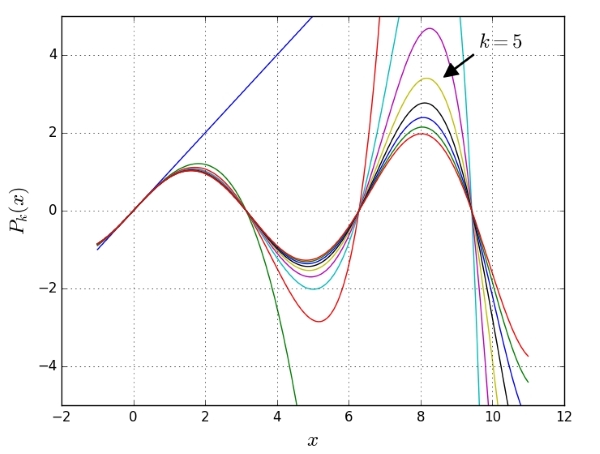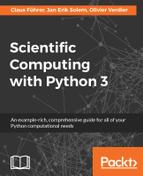Ex. 1 → Compute the value of the sum:

Ex. 2 → Create a generator that computes the sequence defined by the relation:
Ex. 3 → Generate all the even numbers.
Ex. 4 → Let ![]() . In calculus, it is shown that
. In calculus, it is shown that ![]() . Determine experimentally the smallest number n such that
. Determine experimentally the smallest number n such that ![]() . Use a generator for this task.
. Use a generator for this task.
Ex. 5 → Generate all prime numbers less than a given integer. Use the algorithm called Sieve of Eratosthenes.
Ex. 6 → Solving the differential equation ![]() by applying the explicit Euler method results in the recursion:
by applying the explicit Euler method results in the recursion:
Write a generator that computes the solution values un for a given initial value u0 and for a given value of the time step h.
Ex. 7 → Compute π using the formula:

The integral can be approximated using the composite trapezoidal rule, that is, by this formula:

where ![]() .
.
Program a generator for the values yi = f(xi) and evaluate the formula by summing one term after the other. Compare your results with the quad function of SciPy.
Ex. 8 → Let x = [1, 2, 3] and y = [-1, -2, -3]. What is the effect of the code zip(*zip(x, y))? Explain how it works.
Ex. 9 → Complete elliptic integrals can be computed by the function scipy.special.ellipk. Write a function, which counts the number of iterations needed with the AGM iteration until the result coincides up to a given tolerance (note that the input parameter m in ellipk corresponds to k2 in the definition in the section Arithmetic geometric mean) .
Ex. 10 → Consider the sequence defined by:

It converges monotonically to zero: E1 >E2 > . . . > 0. By integration by parts, one can show that the sequence En fulfills the following recursion:
Compute the first 20 terms of the recursion by using an appropriate generator and compare the results with those obtained by numerical integration with scipy.integrate.quad. Do the same by reversing the recursion:
Use the exp function to evaluate the exponential function. What do you observe? Do you have an explanation? (refer to [29])

Figure 9.2: A convergence study of functions approximating to sin(x)
Ex. 11 → The sine-function can be expressed due to Euler as

Write a generator that generates the function values Pk(x). Set x=linspace(-1,3.5*pi,200) and demonstrate graphically how good Pk(x) approximates sin for increasing k. In previous figure (Figure 9.2), the possible result is shown (refer to [11, Th. 5.2, p. 65]).
